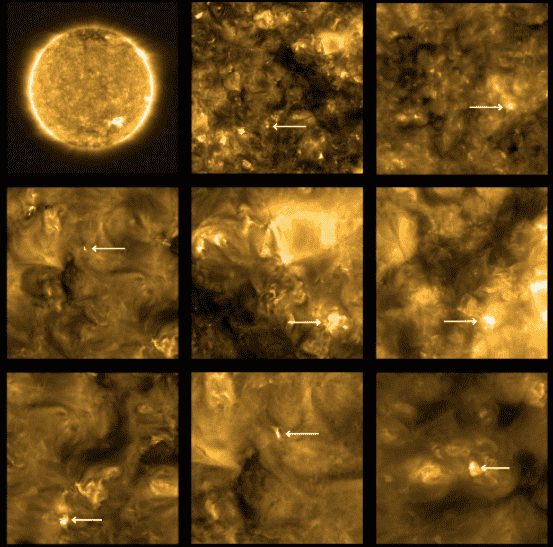Closest pictures ever taken of the Sun reveal 'campfires' or miniature solar flares near its surface

The first images from a new solar mission — the closest pictures ever taken of the Sun — have revealed tiny solar flares, dubbed "campfires", near the surface of our closest star. The campfires were captured by the Extreme Ultraviolet Imager (EUI) from the Solar Orbiter's "first perihelion", the point in its elliptical orbit closest to the Sun. At that time, the spacecraft was only 77 million kilometers (48 million miles) away from the Sun, about half the distance between Earth and the star.
The Solar Orbiter is an international collaboration between the European Space Agency (ESA) and NASA to study the Sun. Launched on February 10, 2020, the spacecraft completed its first close pass of the Sun in mid-June. "These unprecedented pictures of the Sun are the closest we have ever obtained. These amazing images will help scientists piece together the Sun’s atmospheric layers, which is important for understanding how it drives space weather near the Earth and throughout the solar system," says Holly Gilbert, NASA project scientist for the mission at NASA's Goddard Space Flight Center in Greenbelt, Maryland, in a statement.
The Solar Orbiter carries six remote-sensing instruments, or telescopes, that image the Sun and its surroundings, and four in situ instruments that monitor the environment around the spacecraft. By comparing the data from both sets of instruments, scientists will get insights into the generation of the solar wind, the stream of charged particles from the Sun that influences the entire solar system. The unique aspect of this mission is that no other spacecraft has been able to take images of the Sun’s surface from a closer distance.
"These are only the first images and we can already see interesting new phenomena. We didn’t expect such great results right from the start. We can also see how our ten scientific instruments complement each other, providing a holistic picture of the Sun and the surrounding environment," says Daniel Müller, ESA's Solar Orbiter project scientist.
Principal investigator David Berghmans, an astrophysicist at the Royal Observatory of Belgium in Brussels, describes the campfires as "little nephews of solar flares, at least a million, perhaps a billion times smaller." "The Sun might look quiet at the first glance, but when we look in detail, we can see those miniature flares everywhere we look,” says Berghmans.

The scientists do not know yet what these campfires are or how they correspond to solar brightenings observed by other spacecraft. It is not clear yet whether the campfires are just tiny versions of big flares, or whether they are driven by different mechanisms. "But it's possible they are mini-explosions known as nanoflares – tiny but ubiquitous sparks theorized to help heat the Sun's outer atmosphere, or corona, to its temperature 300 times hotter than the solar surface," says the team.
The solar corona is the outermost layer of the Sun’s atmosphere that extends millions of kilometers into outer space. Its temperature is more than a million degrees Celsius, which is orders of magnitude hotter than the surface of the Sun, a "cool" 5500 °C. After many decades of studies, the physical mechanisms that heat the corona are still not fully understood, but identifying them is considered the ‘holy grail’ of solar physics.
"These campfires are insignificant each by themselves, but summing up their effect all over the Sun, they might be the dominant contribution to the heating of the solar corona," says Frédéric Auchère, co-principal investigator of EUI from the Institut d'Astrophysique Spatiale (IAS), France.
To know for sure, scientists need a more precise measurement of the campfires' temperature, and the Spectral Imaging of the Coronal Environment, or SPICE instrument, also on Solar Orbiter, does just that. "So we're eagerly awaiting our next data set. The hope is to detect nanoflares for sure and to quantify their role in coronal heating," says Auchère.
The mission’s four in situ instruments also revealed initial results. The Solar Wind Analyser, or SWA instrument, shared the first dedicated measurements of heavy ions (carbon, oxygen, silicon, iron, and others) in the solar wind from the inner heliosphere.
“We are all really excited about these first images – but this is just the beginning. Solar Orbiter has started a grand tour of the inner solar system and will get much closer to the Sun within less than two years. Ultimately, it will get as close as 42 million km, which is almost a quarter of the distance from Sun to Earth,” says adds Daniel.
Getting to this point, however, was not easy. The coronavirus pandemic forced mission control at the European Space Operations Center, or ESOC, in Darmstadt, Germany, to close down completely for more than a week. During commissioning, the period when each instrument is extensively tested, ESOC staff were reduced to a skeleton crew. All but essential personnel worked from home.
"The pandemic required us to perform critical operations remotely – the first time we have ever done that," explains Russell Howard, principal investigator for one of Solar Orbiter's imagers. However, the team adapted, even readying for an unexpected encounter with comet ATLAS's ion and dust tails on June 1 and 6, respectively. The spacecraft completed commissioning just in time for its first close solar pass on June 15. As it flew within 48 million miles of the Sun, all 10 instruments flicked on and Solar Orbiter snapped the closest pictures of the Sun to date.